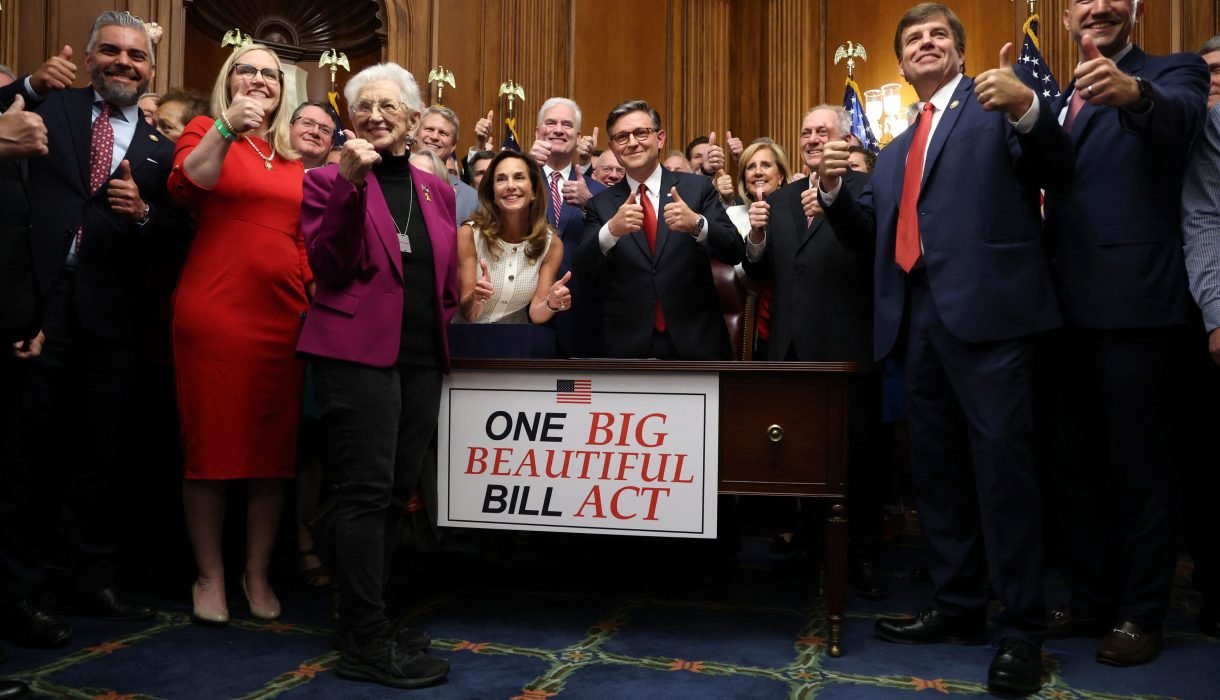
Beyond the Billboard: Dissecting Trump’s “One Big Beautiful Bill” and Its Ripple Effects.
Posted in :
Trump’s “Big Beautiful Bill” passed swiftly with little debate, enacting permanent tax cuts for the wealthy, gutting Medicaid and SNAP, and funneling massive funds into defense. Beneath the patriotic branding lies a sweeping transformation of America’s social contract—one that deepens inequality and redefines democracy.
An unvarnished, human-level exploration of Richard Wolff’s analysis of Trump’s “One Big Beautiful Bill”—breaking down its legislative drama, lasting tax reforms, shifts in social spending, and what it signals about America’s unsteady future.
I’ll never forget sitting on my porch this July 4th, fireworks fizzing in the distance, as my neighbor (a retired teacher) asked me, “Did Congress really pass that ‘Big Beautiful Bill’ overnight?” Confession: I’d only skimmed the headlines—until Richard Wolff’s deep dive sent me tumbling down the legislative rabbit hole. This isn’t just about numbers or speeches; it’s about the precarious balancing act between patriotic pageantry and real-life consequences. Let’s set aside the fanfare and pull apart what’s really packed in Trump’s new flagship law—one part fiscal revolution, one part political performance art.
How the “Big Beautiful Bill” Breezed through Congress (and Dodged Debate)
When I look at how Trump’s “One Big Beautiful Bill Act” made its way through Congress, the process itself tells a story. This wasn’t a typical legislative journey. Instead, Trump’s team relied on budget reconciliation, a legislative shortcut that allowed the bill to pass with just a simple majority. By using this method, they bypassed the usual 60-vote filibuster rule in the Senate. The final Senate vote was razor-thin—51-50—with Vice President J.D. Vance casting the tie-breaking vote. In the House, the margin was just as slim: 218-214. Only two Republicans broke ranks, and both reportedly faced intense pressure from party leadership.
What stands out to me is the speed and secrecy that surrounded the bill. The full text, running over a thousand pages, was released only hours before lawmakers were expected to vote. Most members admitted they hadn’t read the entire bill. Late-night calls, lobbying, and partisan pressure became the norm. This rushed process left little room for public scrutiny or genuine debate. Research shows that such a lack of transparency can undermine trust in the legislative process and raise questions about democratic accountability.
The timing of the bill’s passage was also strategic. Just before the July 4th recess, Trump’s team pushed the bill through, setting up a signing ceremony on Independence Day. This move wasn’t just about timing—it was about symbolism. By signing the Big Beautiful Bill on July 4, the administration framed it as a patriotic achievement, wrapping major policy changes in the language of national pride. Some observers, like Richard Wolff, have called this “political theater,” arguing that the spectacle was designed to distract from the bill’s deeper implications.
The use of budget reconciliation was pivotal for passage, but it also meant that the bill dodged the kind of extended debate and amendment process that often shapes major Trump legislation. As a result, critics argue that the process itself contributed to the current political fallout. Many lawmakers, and much of the public, were left in the dark about the bill’s full impact. As Wolff puts it,
‘This is not just tax reform. It’s social redesign.’
What’s Under the Hood? Permanent Tax Cuts—But Not for Everyone
When I look closely at the “One Big Beautiful Bill Act,” the most striking feature is its approach to tax reform. The bill makes the 2017 Tax Cuts and Jobs Act permanent, especially the corporate tax rate, which is now locked at 21%. For businesses and top earners, this is a major win. The permanence of these tax cuts means that the benefits to corporations and high-income individuals are here to stay, shaping the tax landscape for years to come. Research shows that these changes overwhelmingly reward higher-income groups, while the impact on lower earners is far more limited.
Some of the bill’s headline perks sound appealing—deductions for car loan interest, tips, and second jobs. But when I dig into the details, it’s clear that these benefits mostly bypass the poorest Americans. Many of these deductions require taxable income, so those who earn the least or don’t pay federal income tax get little to no help. This is a pattern repeated throughout the bill: tax breaks that sound broad but, in practice, favor those already doing well.
The Child Tax Credit is another area where the impact is uneven. The credit increases to $2,400 per child, but the full amount only goes to families earning $75,000 or more. For lower-income families, the benefit phases out quickly, meaning the people who could use the help most are left with less. This approach, as Richard Wolff points out, “rewards those above $75,000 earnings,” reinforcing existing economic divides.
There’s also a new Social Security Bonus—$45 a month for some retirees, but only for five years and only for those earning below $48,000. It’s a temporary fix, not a permanent solution, and its renewal depends on future Congressional action. Wolff calls this “vote bait,” a short-term offer that doesn’t address deeper issues facing seniors.
Overall, the tax cuts impact is clear: the bill cements advantages for corporations and wealthier Americans, while offering only unstable or temporary help to others. As Wolff puts it,
“The system is redefining certain Americans … as ‘costs’ to be managed, not as citizens to be supported.”
This shift in tax policy is less about broad-based relief and more about making existing inequalities a permanent feature of the system.
Slashing Social Supports: Medicaid, SNAP, and the DIY Future
One of the most striking aspects of the “One Big Beautiful Bill Act” is its sweeping approach to public assistance cuts. As I look into Richard Wolff’s analysis, it’s clear that these changes go far beyond simple budget adjustments—they signal a major shift in how the U.S. handles its social safety nets, especially Medicaid and SNAP. The Congressional Budget Office estimates that 11.8 million people will lose Medicaid coverage over the next decade. That’s not just a number; it’s millions of Americans, many of them children, seniors, and people with disabilities, suddenly at risk of losing access to basic healthcare.
Wolff calls this not just fiscal tightening, but “organized cruelty.” The Medicaid cuts are spread over ten years, but the effects will be felt almost immediately as states scramble to fill funding gaps or cut services outright. States already struggling with healthcare costs will face tough choices—either raise taxes, cut other programs, or reduce Medicaid coverage even further. The ripple effects are hard to ignore, and research shows that losing Medicaid can lead to worse health outcomes and higher emergency care costs down the line.
The bill also introduces stricter SNAP work requirements. Now, adults aged 18 to 59 must work at least 30 hours a week to qualify for food assistance. For many, especially those in unstable or low-wage jobs, this threshold is difficult to meet. States will also have to shoulder more administrative costs, which could lead to further reductions in benefits or outright closures of local programs. Studies indicate that these changes risk increasing food insecurity, especially among working families and single adults.
Housing support is another area facing significant cuts. The federal budget for housing vouchers is now capped, which means longer waiting lists for families in need. Meanwhile, tax breaks for luxury property developers remain untouched, a detail Wolff highlights as evidence of the bill’s priorities. The result is a growing economic divide: resources are redirected toward those already well-off, while vulnerable groups are left to navigate a shrinking safety net.
The effect is not mere fiscal adjustment but “organized cruelty.”
– Richard Wolff
All of these changes point to a deliberate move away from collective support systems. The emphasis is now on individuals and market solutions, with public assistance cuts making it clear that many Americans will have to fend for themselves in the face of growing needs.
Spending Surges: Defense, Border Walls, and the Expanding Shadow Army
When I look closely at the “One Big Beautiful Bill,” the scale of new spending on defense and border security stands out immediately. Supporters frame these outlays as essential for national safety, but the fiscal implications are hard to ignore. Over the next five years, the bill commits an additional $150 billion to defense spending. This isn’t just about traditional military upgrades—it covers new weapons systems, a rapid expansion in cyber defense, and, notably, a surge in contracts for private military contractors. These groups, sometimes called the “shadow army,” are set to profit handsomely, even as oversight grows thinner. As Richard Wolff points out,
“The bill keeps the U.S. military budget higher than the next ten nations combined.”
The border wall, a signature Trump priority, receives $50 billion in new funding. What’s different this time is the removal of environmental review requirements, which means construction can move faster but with fewer checks on its broader impact. ICE also gets a significant boost—more resources for surveillance, deportations, and the expansion of facial recognition technology at airports and in urban areas. These changes reflect a strategic shift: more money for enforcement, less for oversight or humanitarian review.
While these spending surges are celebrated by some, international organizations and fiscal experts are sounding alarms. The Congressional Budget Office (CBO) estimates that the Big Beautiful Bill will add between $3 and $3.4 trillion to the national debt over the next decade. The International Monetary Fund (IMF) has gone so far as to call the bill “fiscally reckless,” warning of possible market instability and future inflation risks. Research shows that such sharp increases in defense spending, especially when paired with tax cuts and reduced safety net programs, can deepen economic divides and threaten long-term fiscal health.
It’s also worth noting that these massive outlays for defense and border security come as the bill makes deep cuts elsewhere—Medicaid, SNAP, and housing assistance all face reductions. This contrast is stark: resources are being shifted toward military and enforcement priorities, while support for vulnerable populations shrinks. For many critics, this isn’t just a question of budget math, but a fundamental reordering of national priorities.
Redrawing the Social Contract: Fraying Democracy and Public Backlash
As I reflect on the passage of the “One Big Beautiful Bill,” it’s clear that this legislation is about much more than tax cuts and spending priorities. The process itself has become a focal point for public reaction and political fallout. Lawmakers were pushed hard—sometimes with late-night calls, campaign threats, or promises of support—to secure the votes needed. Many admitted they hadn’t even read the full bill before casting their votes. This kind of “manufactured consent through intimidation,” as Richard Wolff describes it, raises serious questions about the state of democracy in America.
The public’s response is deeply divided. According to a recent Reuters/Ipsos poll, 49% of Americans oppose the Big Beautiful Bill, while only 29% support it. The rest either aren’t sure or haven’t heard enough to form an opinion. This gap in awareness isn’t accidental; Wolff calls it “engineered silence,” pointing to the rushed timeline and lack of open debate. Media reports and expert commentary have highlighted how little time was given for public scrutiny or even for lawmakers to understand the full scope of the changes.
What stands out to me is how this bill seems to redraw the boundaries of citizenship and the social contract itself. Instead of strengthening shared safety nets, the legislation leans heavily on market solutions and individual responsibility. As public programs like Medicaid and SNAP face cuts, and as tax benefits skew toward higher-income groups, the economic divide could deepen. Research shows that many Americans are left feeling uninformed and powerless, while the political risks for those who supported the bill are already surfacing—some dissenting lawmakers are facing primary challenges, and the potential for electoral backlash is real.
Wolff’s perspective is that this isn’t just about fiscal policy—it’s about redefining who counts as a “contributor” and who is seen as a “cost.” The rushed process, limited transparency, and intense pressure on lawmakers all point to a crisis in democratic legitimacy. As Wolff puts it,
‘This legislative “win” may sharpen divisions rather than cement unity.’
The Big Beautiful Bill, for all its patriotic branding, may end up being remembered less for its policy details and more for the way it exposed and intensified the fractures in American democracy and society.
TL;DR: The “Big Beautiful Bill” is more than flashy headlines: it rewires tax law, social safety nets, and federal priorities, intensifying the economic divide and testing the nation’s core democratic processes. Understanding it means looking past the spectacle to who wins, who loses, and why it matters for everyone.
BigBeautifulBill, TrumpLegislation, TaxCutsImpact, MedicaidCuts, BudgetReconciliation, HigherEducationChanges, CorporateTaxRate, PublicAssistanceCuts, SNAPWorkRequirements, EconomicDivide,Taxcuts2025, MedicaidandSNAPcuts, Trumpeconomicagenda, politicaltheater, RichardWolffanalysis
#BigBeautifulBill, #TrumpLegislation, #TaxReform, #EconomicDivide, #MedicaidCuts, #SNAPChanges, #HigherEd, #FiscalPolicy, #PoliticalFallout,#TrumpLegislation, #BigBeautifulBill, #TaxCuts2025, #MedicaidCuts, #SNAPReform, #DefenseSpending, #DemocracyUnderThreat, #RichardWolffAnalysis

